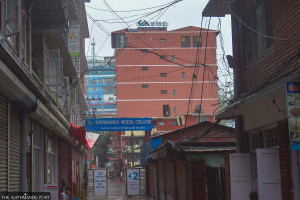Money
Managing Forex Risk in Hydropower
Sharing of foreign exchange risks between govt and consumers seems to be a workable solution
Pradeep Gangol
At present, FDI-funded hydropower projects that are at advanced stages of implementation are Arun III (900MW), Upper Karnali (900MW), Tamakoshi-III (650MW), Upper Marsyangdi -2 (600MW) and Upper Trishuli-1 (216MW). The Upper Trishuli-1 will meet the domestic energy demand, whereas the four others are basically export-oriented projects.
The importance of FDI in economic development cannot be under-estimated. It is a risk-free investment. It enables the government to invest in other sensitive areas like health, education, poverty alleviation and social welfare. It is also a reliable source to increase foreign currency reserves. The sector has the potential to attract the largest amount of FDI into Nepal. The experience of South Asian economies tells us that FDI can be extremely useful for emerging economies, if used strategically.
Nowadays, we frequently read news about the merits/demerits of signing Power Purchase Agreement (PPA) in foreign currency terms with FDI-funded developers. It is very much surprising and such news saps the confidence of foreign investors. As discussed above, we definitely need FDI to compliment the development efforts of the government. Once we make policy to attract FDI in hydropower development, we must have policies and Acts and regulations that are investor friendly. It is natural that foreign investors would like to receive profits in terms of the currency that they invest in. Assets, liabilities and cash flows are affected when changes or fluctuations occur in exchange rates between two currencies. Therefore, ways and means should be found out to manage the foreign exchange risks.
In the case of hydropower projects built by the public sector, either funded by foreign grant or foreign loan, the government usually bears the foreign exchange risks during the repayment of loan and is not passed on to the utility and subsequently to the consumers.
However, when private sector builds a hydropower project, either funded by foreign equity or foreign loan, the developer cannot absorb such risks. Thus, the foreign exchange risk is passed on to the utility which buys power and subsequently to its consumers.
One school of thought is that the government is responsible for the overall management of the national economy and therefore it is the duty of the government to see that its economy is stable and its currency is strong. However, a counter argument to thus school of thought is that there are various players over which the government cannot have control and therefore it has limited role in strengthening the economy and subsequently the national currency. If the government is taking foreign exchange risks, it means it is subsidising the electricity price. Therefore, on the basis of “users pay” principle, the consumers should bear such foreign exchange risks.
One counter argument to this argument is that there are other secondary benefits, besides power, like access roads, school buildings, health posts, trails, rural electrification, employment generation, income generation and local shares, among others, that are being generated by the project during the construction and operation and are not reflected on the electricity price.
Moreover, the whole plant will be owned by the government, free of cost, after the expiry of the concession term. By positively contributing to the national economy, these secondary benefits are ultimately generating additional revenues (from the power to run industries and carry out business activities to reducing petroleum imports) to the government. Consid-ering these indirect benefits, the government therefore should share the risks.
Regarding the allocation of risks to investors, they naturally will expect a higher rate of return on their investment as compensation for bearing foreign exchange risk. Typically, an investor will attempt to achieve this higher rate of return by demanding higher tariffs. Consumers, or the government, may question whether they are getting “good value” from such an arrangement, when the exchange risk is allocated to investors, if they can bear the risk at a lower cost.
One option might be that the risks may be insured. However, commercial insurance companies willing to bear such risks might not be available in the market, and even if available, the high premium rate in such cases will make this option impractical.
Therefore, taking into account both the inability of the investors to take up such risks and affordable electricity price for the consumers, the government and the consumers should share the foreign exchange risks.
This sharing of foreign exchange risks may be from the beginning of the operation period till the end of the concession period or one may bear the foreign exchange risk during one part of the operation period while the other may bear it for the rest of the period. While passing down the risks to the consumers, only “capable” consumers should be selected, who can afford to absorb such risks like commercial entities, corporate houses and factories, among others.
Such sharing mechanism may be reasonable and logical as long as the hydropower project serves the domestic market only. In the case of export-oriented projects, power importing country will receive more secondary benefits, and therefore, sharing of foreign exchange risk should be limited to projects that supply power to the domestic markets only.
Another way to minimise the foreign exchange risk and eventually reduce the burden on national economy is to arrange financing of hydropower projects
from domestic financial markets as much as possible, particularly for projects supplying power to the domestic market.
Lending activities of the Hydroelectricity Investment and Development Company Limited (HIDCL) established to invest capital, as either debt or equity in hydroelectricity generation, transmission and distribution projects, might be a modest attempt towards seeking to reduce financial burden to the government from foreign exchange risks. The revenue received as capacity and energy royalties can be used as fund for equity and loan investment.
Similarly, the proposal of the International Finance Corporation (IFC) to issue around $500 million worth of local currency bonds in Nepal will go a long way in mitigating the foreign exchange risks from foreign direct investment in projects ranging from infrastructure, banking and telecommunications to agro-business and tourism, among others.
The sharing of foreign exchange risks between the government and the consumers seems to be a workable solution. The sharing of such risks by the government will prod the government to put the economy in “good shape” and make the domestic currency stable which will eventually minimise the foreign currency risks. The sharing of risks by selective consumers will help in the judicious use of electricity by the consumers.
When the country is reeling under an unprecedented energy crisis, the best option is to generate more electricity so as to end load-shedding at the soonest time possible. Therefore, power purchase agreements to be signed with foreign developers in foreign currency terms will attract more investors to develop Nepal’s hydropower projects. It is high time the Nepal government work out a clear cut mechanism regarding the sharing of foreign exchange risks.
(Gangol is a hydropower Engineer. He can be reached at prdpgl@gmail.com)




 23.25°C Kathmandu
23.25°C Kathmandu

















